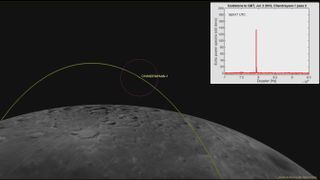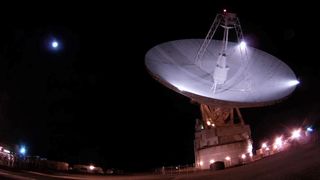Long Lost Indian Moon Probe Found by Earth-Based NASA Radar

Powerful radar beamed from Earth has found a tiny Indian moon probe that last contacted its handlers more than seven years ago.
Scientists used the radar to spot India's 5-foot-wide (1.5 meters) Chandrayaan-1 lunar orbiter, which studied the moon from October 2008 through August 2009.
Despite the potential influence of mountains and other "mass concentrations," which can shift a probe's path, Chandrayaan-1 was more or less where team members expected it to be — in a polar orbit about 125 miles (200 kilometers) above the lunar surface. [The Moon: 10 Surprising Lunar Facts]

"It turns out that we needed to shift the location of Chandrayaan-1 by about 180 degrees, or half a cycle from the old orbital estimates from 2009," detection team member Ryan Park, the manager of the Solar System Dynamics group at NASA's Jet Propulsion Laboratory in Pasadena, California, said in a statement. "But otherwise, Chandrayaan-1's orbit still had the shape and alignment that we expected."
The researchers used the 230-foot (70 meters) antenna at NASA's Goldstone Deep Space Communications Complex in California to beam microwaves toward the moon in July 2016. They then studied the radar "echoes" that bounced back to Earth using the 330-foot (100 m) Green Bank Telescope in West Virginia. Some follow-up observations were also made by the 1,000-foot-wide (305 m) radar dish at Arecibo Observatory in Puerto Rico.

These echoes picked out Chandrayaan-1, India's first moon probe, as well as NASA's Lunar Reconnaissance Orbiter (LRO). Finding LRO was less of a challenge and more of a proof of concept; it's an active spacecraft, so precise location data from the mission's navigators guided the search, detection team members said.
Astronomers commonly use this "interplanetary radar" technique to detect and characterize asteroids. But employing it to find a lost probe in lunar nd-based radars could possibly play a part in future robotic and human missions to the moon, both for a collisional hazard assessment tool and as a safety mechanism for spacecraft that encounter navigation or communication issues," NASA officials wrote in the same statement.
Get the Space.com Newsletter
Breaking space news, the latest updates on rocket launches, skywatching events and more!

The $504 million LRO mission launched in June 2009. The probe worked for about a year as a scout, gathering data that may be useful for future crewed journeys to the moon; it shifted to more of a pure-science mode in September 2010.
The Chandrayaan-1 also included an impactor, which was released from the orbiter in November 2008. The impactor's violent arrival on the moon in November 2008 revealed evidence of water ice on the lunar surface.
India aims to launch its second moon mission, Chandrayaan-2, in early 2018. The mission will consist of an orbiter, lander and rover.

Follow Mike Wall on Twitter @michaeldwall and Google+. Follow us @Spacedotcom, Facebook or Google+. Originally published on Space.com.
Join our Space Forums to keep talking space on the latest missions, night sky and more! And if you have a news tip, correction or comment, let us know at: community@space.com.

Michael Wall is a Senior Space Writer with Space.com and joined the team in 2010. He primarily covers exoplanets, spaceflight and military space, but has been known to dabble in the space art beat. His book about the search for alien life, "Out There," was published on Nov. 13, 2018. Before becoming a science writer, Michael worked as a herpetologist and wildlife biologist. He has a Ph.D. in evolutionary biology from the University of Sydney, Australia, a bachelor's degree from the University of Arizona, and a graduate certificate in science writing from the University of California, Santa Cruz. To find out what his latest project is, you can follow Michael on Twitter.
